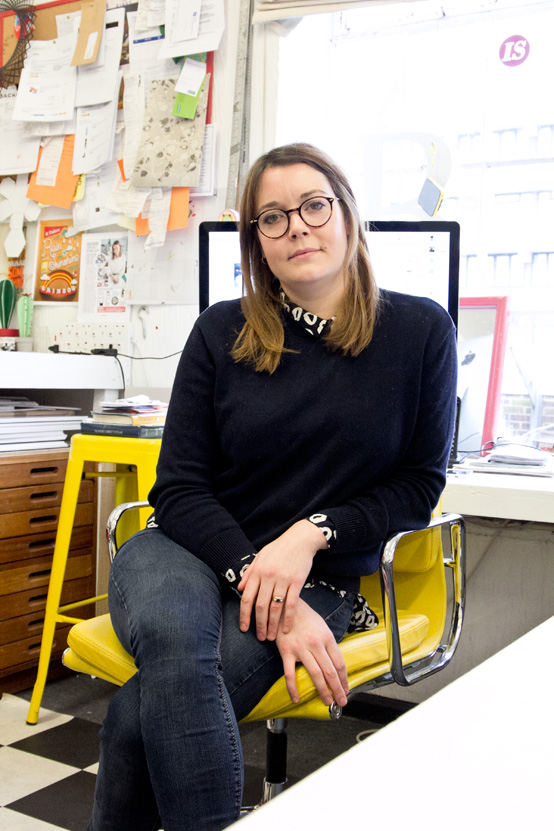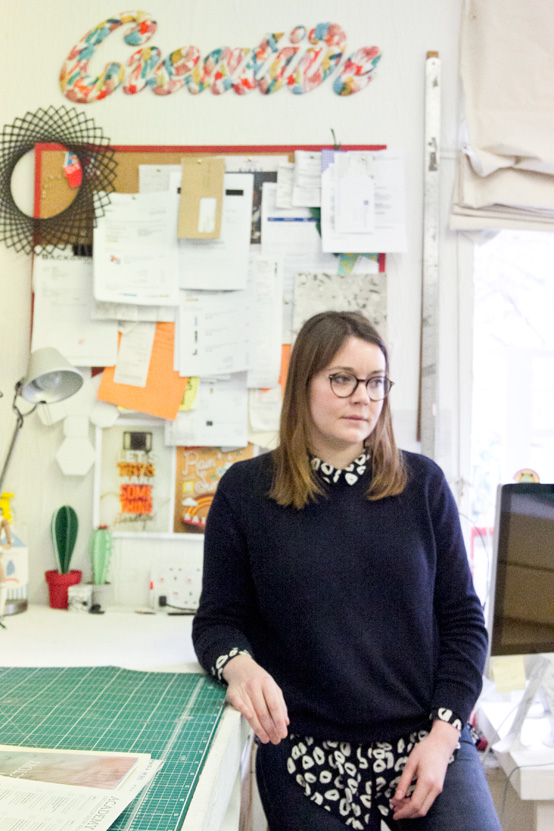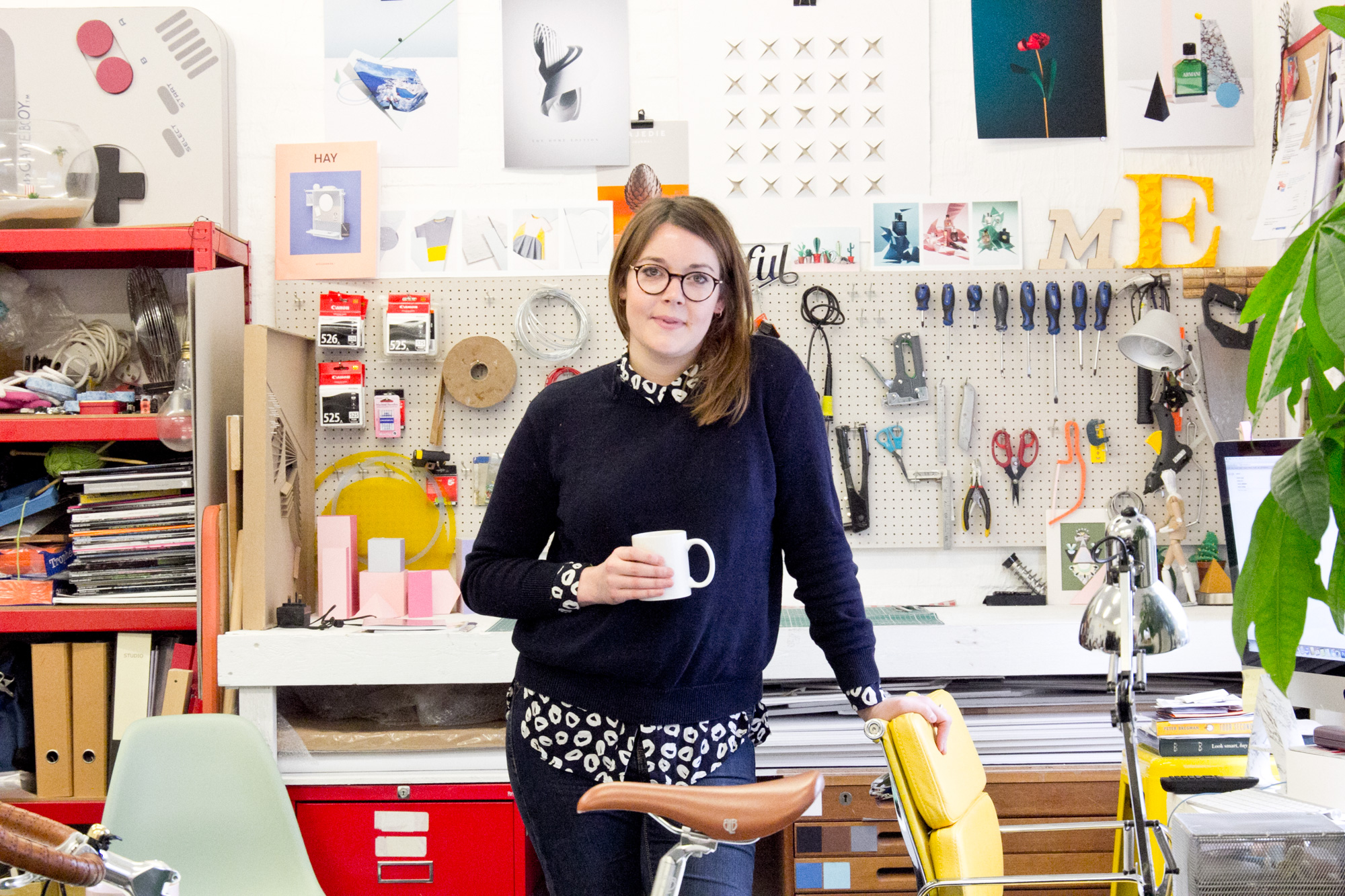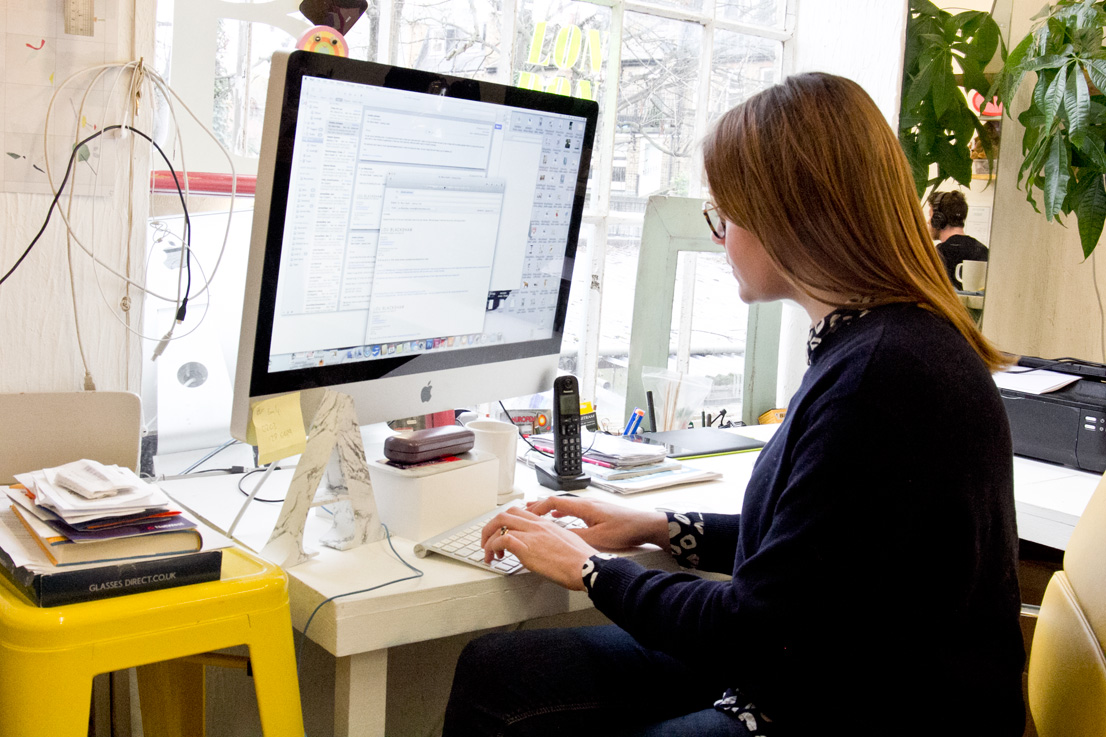 Paper and a pair of scissors might sound humdrum and every day but the humble tools are largely responsible for taking set and prop designs to new heights when in the hands of set designer, Lou Blackshaw. Over the years, she’s used them to animate bold editorials for titles like Stylist, The Times and The Telegraph, not to mention putting them to work on expertly judged campaigns for John Lewis, Selfridges, Harrods and Cos x Hay. Thanks to social media, we’ve never been quite as visual as we are now and well-conceived set designs have become more important than they’ve ever been.
Paper and a pair of scissors might sound humdrum and every day but the humble tools are largely responsible for taking set and prop designs to new heights when in the hands of set designer, Lou Blackshaw. Over the years, she’s used them to animate bold editorials for titles like Stylist, The Times and The Telegraph, not to mention putting them to work on expertly judged campaigns for John Lewis, Selfridges, Harrods and Cos x Hay. Thanks to social media, we’ve never been quite as visual as we are now and well-conceived set designs have become more important than they’ve ever been.
Interestingly, despite her bold and larger than life creations, in person Lou is softly spoken, and charmingly shy. It’s only when she starts talking about her work that she becomes animated, punctuating her sentences with laughter. It’s as though her inner extrovert is channelled through the work.
Since going out on her own after a stint assisting, she’s become the go-to person for the big papers through to the more creative, boundary pushing style titles. But although she was always artistically minded finding her way to set design took time. Born and raised in the Midlands, it never occurred to her that she could actually make a living off a passion project and, after graduating from Bristol University, it took a while before she spurred up the courage to move to London and really give it a go.
We meet in her studio, a little bolthole nestled in a mews off a busy road near Clapham rather than the veritable hub of British creatives in East London. Her workspace is surprisingly tidy and stripped back, save for a cutting station filled and a wall filled with cuttings, tools and inspiration. She’s a firm believer that the photograph is the true end product, so she’s no precious about keeping hold of all of the props she creates.
Her creative process often begins with little more than a hunch. Where the client hasn’t been prescriptive with a brief, a whole set might start with a visual she saw recently or an attitude, art, music or something she’s seen editorially. Even after a concept has been approved, last minute changes are inevitability, she tells me and it’s Lou’s flexibility that’s worked. It was through assisting and making an impression that she was able to give up her part-time job; the more she assisted, the more clients passed jobs her way. Everything has snowballed off the back of somebody she’s worked with and made an impression on.
She’s the first to admit that her career hasn’t been one of glamorous play, though. Her is often centred around trudging props and late nights trying to finish creating things all to create that seemingly effortless, manicured final product. Here, she shares how she managed to get her foot through the door, the whole creative process of bringing a client’s idea to life and why learning on the job is the most important thing of all…
I studied Illustration at Bristol UWE after a yearlong foundation course. I chose it because I could see a career path that I could follow at the end of it. I wanted to make sure that I could take the skills I learnt over the four years into the real world. To be honest, I wasn’t sure then that I even wanted to be an illustrator, as I’m not really a drawer. Luckily, I had some brilliant tutors that encouraged lots of different approaches to the briefs we were given. I’ve always worked best in 3D and at uni I used a lot of collage and paper cutting in my work. My tutor used to say I drew with scissors and I often found myself making something and taking pictures of it. At that stage, I didn’t really know what a set designer did, but that’s exactly what I do now. Uni taught me how to apply myself and it gave me the image making skills that I use today. I think formal training is really important in this industry. It taught me all the core skills I needed to start. We did everything from print making to book binding and pop up book classes. We also had regular talks from people in the industry, which gave us a good insight into the challenges of freelance life (as well as the perks!). Everything I learnt over the four years I use in some degree on a regular basis. You can take what you want from each experience.
I worked all through Christmas to my Selfridges project done in time, and to this day I still don’t know how I did it, but the feeling I got standing on Oxford Street looking at it was amazing. Knowing I had made it myself and everyone could see it was wonderfully satisfying. I needed to prove to myself that I could do it. After that I knew that if I applied myself and started to get more of my own clients, I could definitely turn my love into a viable career.
As they say, the majority of the skills you learn are on the job. I definitely didn’t learn how to be a set designer at uni. I assisted a lot at the beginning, as I think it’s the best way to learn, without the pressure of having the whole job on your shoulders. It was an invaluable time for me and I was like a sponge, absorbing everything around me. I learnt everything from how to deal with clients, how to behave on set to where the best places to buy props from were. To be honest I am still learning now, I’m not sure I’ll ever stop. Every set design job is different, which I love, and it means I am always adapting and picking up new skills. The most important thing I’ve learnt is to have confidence in myself. I know that I will never let anything leave the studio that isn’t something I’m proud of. Once that was in my mind, even during the toughest of jobs I knew that somehow I would figure it out and it would be fine.
I have always known that I would have a creative job. I was always the arty one at school and at home, so I think it was a case of just finding the right career that suited me. Once I had moved to London and started assisting, I quickly started to see how the industry works. I could picture myself doing the job and at that point I knew it was right for me. It was only once I had done my first few jobs though that I realised I could actually make a career on my own. I remember my first ever job, which was through a contact of somebody I was living with at the time. It was for Bright Young Things at Selfridges where they showcased up and coming designers. I did one of the windows for a fashion designer, which was a life size, all-white-paper scene of a running wolf and hare with a man riding a motorbike. I worked all through Christmas to get it done in time, and to this day I still don’t know how I did it, but the feeling I got standing on Oxford Street looking at it was amazing. Knowing I had made it myself and everyone could see it was wonderfully satisfying. I needed to prove to myself that I could do it. After that I knew that if I applied myself and started to get more of my own clients, I could definitely turn my love into a viable career.
When I graduated I didn’t really know what to do. It is a very daunting process as you are suddenly all on your own. I’d like to say I moved straight to London and started assisting, but I didn’t. I worked in Bristol for a bit, which gave me some time to figure out the route I wanted to take. I think I was quite intimidated by the prospect of London. I knew how competitive it is and I was worried that I would struggle. Once I did get here though and I dived into what there is to offer, it became far less intimidating. I got a part-time job as a creative PA when I arrived, just to help me financially. It was very flexible though which meant that when I got assisting jobs, I was able to take them and fit my other job around that. It was a gradual process, but I started to reduce my PA hours as I got more assisting work. Once I was assisting more I started to get more of my own work and from then I started assisting less and taking on more of my own jobs. Once I felt like I had a steady income I took the jump and got my own studio. It was then that my work started snowballing.
Getting your foot in the door as a freelancer and finding paying clients is all about meeting people. I did a lot of low paid jobs to start with, but I made sure I did them as well as I possibly could, often taking more time over them. I always make sure I had good photos of everything I made too so I could use them in my portfolio. Slowly it grew and I started getting small editorial jobs. I must have been doing something right as they started commissioning me more often and soon I had a couple of regular clients, which I loved. From these editorial jobs I met a lot of new photographers, which was so important as set designers need photographers and visa versa. Establishing relationships is very important and even more important to maintain. I love chatting to people, so that helps, but I find that just being friendly, professional and making sure the job run smoothly is enough to keep everyone happy. Relationships with other creatives are just as important, as photographers, for example, will often ask me to help out on their jobs, which is a good way of getting new clients. I also ask them to shoot my jobs in return sometimes. It’s a nice relationship to have. It’s also means you can collaborate on personal projects when work is quiet too.
You will always encounter challenges when you first start out as a freelancer but one of the main things I found was the whole process of adapting to how unpredictable freelance life actually is. It’s amazing and I love it, but it has taken some getting use to. Some of my friends can’t bare the idea of not knowing where their next pay cheque is coming from. It’s definitely not for everyone. I think for me, I’ve just had to learn to know that work will come in and that I can’t control it. Some months are quiet and I used to panic when that happened, but it does even itself out in the end. It also means managing my finances can be difficult at times and it can be tricky to plan ahead or save. My advice would be to get a good accountant. If you’re anything like me and maths isn’t your strong point, it’s always good to have someone to go to for advice.
The most important thing I’ve learnt is to have confidence in myself. I know that I will never let anything leave the studio that isn’t something I’m proud of. Once that was in my mind, even during the toughest of jobs I knew that somehow I would figure it out and it would be fine.
I think taking risks is vital in this industry. I wouldn’t be where I am if I hadn’t. When I arrived in London I tried to make a plan of what I was going to do and I think it’s fair to say I didn’t stick to it. It’s not to say that I didn’t try, but I realised that when I took risks and opened new doors, it gave me more opportunities. I think it’s good to not be afraid of changing the way you work too. My work has changed along the way and that’s because I’ve challenged myself. It a continuous journey.
As more people go freelance, one of the most important ways to separate yourself now is to have a strong online presence. My website is my shop window, which allows me to showcase my work in the best possible light. I think it is essential to present yourself well. I’m naturally quite an impatient person and I like the fast pace of the industry and the fact that I get to work on different jobs each week, so I try and reflect that in my website. I update it regularly with any new work, and I always try and keep the images looking clear and professional. Potential clients book you based on your aesthetic so it’s important to have a strong visual identity online. It helps people understand your place in the industry and it should always reflect the type of jobs you’re trying to attract. My advice with all things digital is to make sure that anything you put up is deliberate and truly reflects your brand because nowadays, that’s what clients will be judging you on. Most of my clients do come to me because of my aesthetic. I feel very lucky that I have a constant stream of work and most of the time they fit into the kind of style I work in. There are some cases though when a job isn’t suitable and I turn it down, but to be honest it happens less nowadays. When it does happen though I will do my best to find someone suitable to take the job. When I started out, I got my foot through the door through people recommending me so I’ll always recommend one of my assistants as I think they’re the right. It’s so important not to forget how difficult it was when you were starting out. I always try to spread the love.
Every job is different and so they each have different creative processes. Usually the client has a brief that they present to me and my job is to make it happen. A typical editorial job, for example, will be following a brief from the picture editor. The first questions I always ask is whether they have a mood board and what the timescale and budget is. From that I can determine how long I think the job will take and whether it fit’s within my timescale. Being a creative person, I find it quite easy to visualise what the client is trying to create. If the client is unsure, I enjoy the challenge of exploring options with them to find something they are happy with. I really enjoy the creative process so the more input I can have in the conception stage, the more rewarding I find it. I always prefer to be involved in projects from the beginning to the end. After discussing the details I will find the best way to bring it to life that fits within the budget. I prep in the studio either designing or making and then I take what I have to a photographer to shoot. I will work closely with the photographer on the shoot day and style the shots to create the image we’re after. Usually the turn around is quite quick, especially in the editorial world, but I’m used to it now and I actually enjoy the pace and the challenges that brings.
 Being creative is at the heart of what I do but there are times where I definitely have dry spells and start getting frustrated. I think it is normal though and I find getting out really helps. Being freelance can sometimes get a bit lonely if you aren’t busy so I take myself to an exhibition or even just go take my laptop to work in a coffee shop for a day. The best thing I find is to work on collaborative personal projects with photographers. It stops me from getting stale and often the work we produce can turn into great additions for my portfolio that help bring more work in later down the line.
Being creative is at the heart of what I do but there are times where I definitely have dry spells and start getting frustrated. I think it is normal though and I find getting out really helps. Being freelance can sometimes get a bit lonely if you aren’t busy so I take myself to an exhibition or even just go take my laptop to work in a coffee shop for a day. The best thing I find is to work on collaborative personal projects with photographers. It stops me from getting stale and often the work we produce can turn into great additions for my portfolio that help bring more work in later down the line.
Stress is something I’ve learnt to deal with. The nature of being a set designer is that things do change along the way: either clients change their mind or something isn’t working on the shoot day. The trick is to try not to panic under the pressure. There is a huge amount of responsibility, especially on the bigger budget jobs, but you do get used to it. If something isn’t working on set, I know that if I battle through it and have the confidence in myself to do so, eventually I will make it work.
I’d say at the moment my jobs are about 70% editorial and 30% commercial. But it does change each month. It’s really good to have the balance of both though. I find that editorial can be a bit more flexible creatively, and you get to work more closely with the client. The budgets are often smaller, but if we need to change the design or something isn’t working, they tend to be more flexible. Advertising is a bit different but also has a lot of pluses. The budgets are bigger and I get to work with fantastic photographers from all over the world.
I recently did the cover of British Airways First magazine, which is definitely one of the projects I’m most proud of. I was asked to create a shell sculpture out of paper. It was unexpectedly challenging, but I loved the process of creating an organic form out of one piece of white paper. It was the first time that I have done a piece of work without any product with it. It was all about the shell sculpture and the making process behind it. The client also sent a film crew round to my studio to film me making it and they filmed the shoot to create a behind-the-scenes video too. It was really good to create a piece of art for a change. I’ve now got it hanging in my bathroom.


